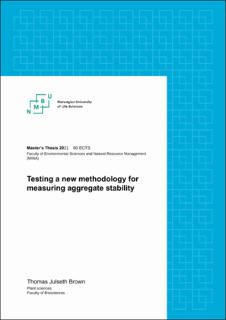| dc.description.abstract | Soil aggregate stability is an important measure of a soils’ physical and structural condition. Good aggregate stability is paramount in order to sustain crop productivity, limit soil erosion and promote healthy and sustainable soil. Improving aggregate stability promotes an idealistic soil state known as optimal tilth. In such conditions, the soil is perfectly loose and porous to allow for the assemblage of stable aggregates, which further enhances free infiltration and movement of water and air, resulting in easy cultivation and planting, unobstructed germination, seedling emergence, and growth of roots. In other words, good aggregate stability is crucial for sustainable agriculture. Most conventional aggregate stability measurement methods currently used are difficult to operate, slow, expensive, and require a laboratory. The conventional method used in this thesis is the rainfall simulator, which is the standard aggregate stability measurement method used at the Norwegian University of Life Sciences (NMBU). An application called SLAKES may be on the verge of offering an alternative to the older existing aggregate stability measurement methods. SLAKES is an application invented in Australia by the University of Sydney. In contrast to the conventional methods, SLAKES offers an easy, quick, and inexpensive method of measuring aggregate stability. In addition, no laboratory is needed, and SLAKES is available to anyone who owns a smartphone. After 10 mins, SLAKES is able to produce an aggregate stability measurement that is displayed on the smartphone screen using only water, a petri dish, 3 soil aggregates (2- 15 mm), and a smartphone with the SLAKES application installed. A text-file including additional data is automatically downloaded to the smartphone’s memory after the 10 min slaking interval. Four experimental sites are used to measure aggregate stability with SLAKES and the rainfall simulator: one organic fertilizer experiment and three tillage experiments. The aim is to determine if SLAKES can detect differences between treatments, and if these differences correspond to the results from the rainfall simulator. All four experimental fields have different soil textures: Silt loam, silty clay loam, clay, and sandy loam. In two out of three fields, mean values from SLAKES show higher significant separation between treatments than the rainfall simulator. In one field, significance cannot be established as there is only one repetition. Analysis suggests that the rainfall simulator can better detect correlations between aggregate stability and organic matter than SLAKES. Although SLAKES has flaws, this thesis gives evidence to suggest that the application is a valid alternative to conventional aggregate stability measurement methods such as the rainfall simulator. | en_US |

